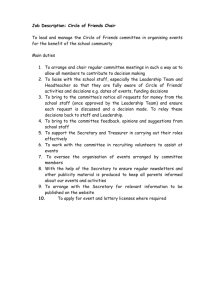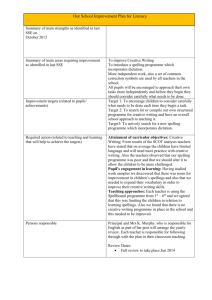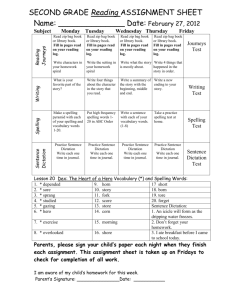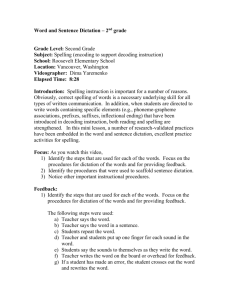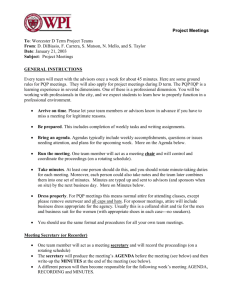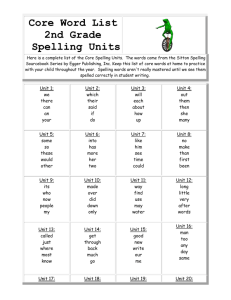Collaborative Learning and Classroom Feng Shui
advertisement
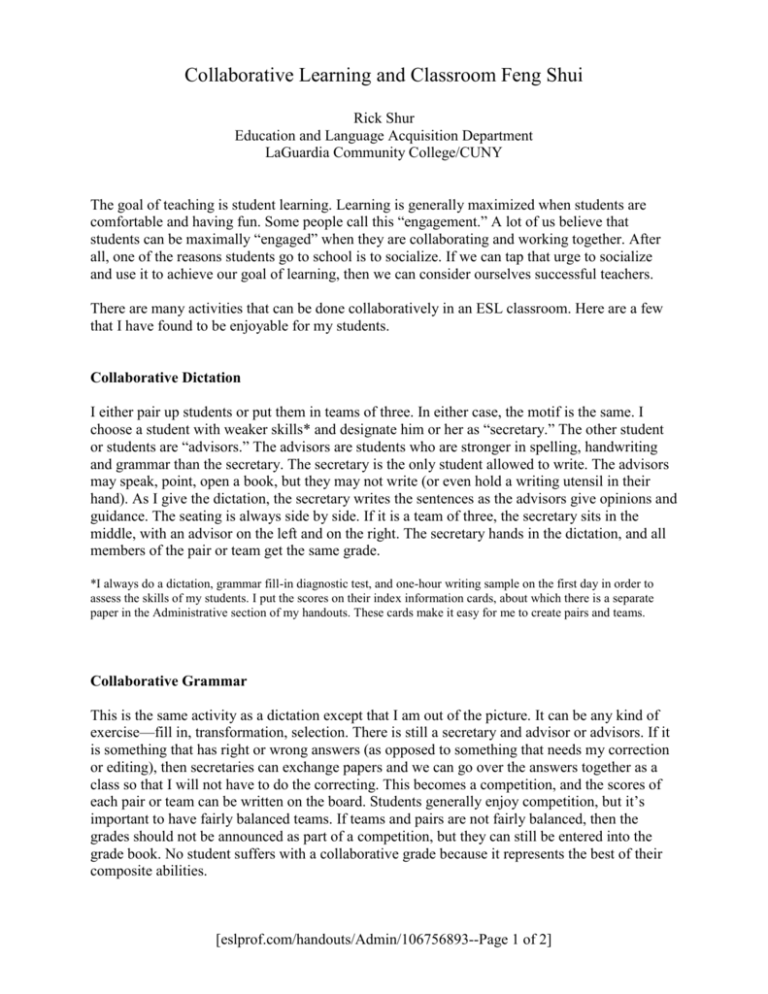
Collaborative Learning and Classroom Feng Shui Rick Shur Education and Language Acquisition Department LaGuardia Community College/CUNY The goal of teaching is student learning. Learning is generally maximized when students are comfortable and having fun. Some people call this “engagement.” A lot of us believe that students can be maximally “engaged” when they are collaborating and working together. After all, one of the reasons students go to school is to socialize. If we can tap that urge to socialize and use it to achieve our goal of learning, then we can consider ourselves successful teachers. There are many activities that can be done collaboratively in an ESL classroom. Here are a few that I have found to be enjoyable for my students. Collaborative Dictation I either pair up students or put them in teams of three. In either case, the motif is the same. I choose a student with weaker skills* and designate him or her as “secretary.” The other student or students are “advisors.” The advisors are students who are stronger in spelling, handwriting and grammar than the secretary. The secretary is the only student allowed to write. The advisors may speak, point, open a book, but they may not write (or even hold a writing utensil in their hand). As I give the dictation, the secretary writes the sentences as the advisors give opinions and guidance. The seating is always side by side. If it is a team of three, the secretary sits in the middle, with an advisor on the left and on the right. The secretary hands in the dictation, and all members of the pair or team get the same grade. *I always do a dictation, grammar fill-in diagnostic test, and one-hour writing sample on the first day in order to assess the skills of my students. I put the scores on their index information cards, about which there is a separate paper in the Administrative section of my handouts. These cards make it easy for me to create pairs and teams. Collaborative Grammar This is the same activity as a dictation except that I am out of the picture. It can be any kind of exercise—fill in, transformation, selection. There is still a secretary and advisor or advisors. If it is something that has right or wrong answers (as opposed to something that needs my correction or editing), then secretaries can exchange papers and we can go over the answers together as a class so that I will not have to do the correcting. This becomes a competition, and the scores of each pair or team can be written on the board. Students generally enjoy competition, but it’s important to have fairly balanced teams. If teams and pairs are not fairly balanced, then the grades should not be announced as part of a competition, but they can still be entered into the grade book. No student suffers with a collaborative grade because it represents the best of their composite abilities. [eslprof.com/handouts/Admin/106756893--Page 1 of 2] Collaborative Writing Again, there is a secretary and advisor or advisors, but the task is to create something, like a paragraph (all teams start with the same topic sentence that they have to amplify with details and examples) or a short story that has a beginning but no conclusion, or a guided essay with introductory sentences for each paragraph but no bodies. Once completed, one of the advisors reads the team’s writing to the rest of the class so that students can hear each other’s approaches to the task. Games A lot of learning can be done in a game format. Students enjoy spelling bees, and they are a good way to deal early with spelling demons (especially gh and th words, ing forms, words with double or single letters that get confused), and other factual contests can be held in the form of a spelling bee. One task can be to give the irregular past tense of an irregular verb (by spelling it), or to give the past and past participle of an irregular verb. In spelling bees, students who answer incorrectly or not fast enough are told to sit down. The object is to remain standing. Games can be played in pairs, triplets or quartets. A pile of cards can be created by a team, containing any words that need to be learned. For example, an irregular verb can be on one side of the card and the past and past participle on the opposite side. Students take turns guessing the past and past participles and keep any card for which they answer correctly. Incorrect responses go back into the pile. Eventually, the pile is used up and somebody has the most cards. Other word lists can include words with their antonyms on the reverse side of a card, country names and languages, country names and capital cities, singular nouns and their plural forms, and, if you want to get creative, cards with pictures on one side and the words on the reverse. This kind of activity, which gets students to create their own materials, has many advantages. First, you can keep the product for future use. Second, students can socialize a lot talking about pictures that they want to cut out of magazines or print off of the internet to create vocabulary lessons for themselves. Categories that are always useful include fruits, vegetables, appliances, rooms of the house, furniture, clothing, parts of the body, well known places, objects seen outdoors, and animals. Class Feng Shui The only way to have a class conversation is to put the chairs in a circle. It has to be a real circle, too, not an oval or half circle. The feng shui is extremely important, and I am never shy about demanding that the students make the most beautiful circle they possibly can. Why? Because the more perfect the circle, the more equal the participants. In a class conversation, you want everyone to feel equal. That is how the United Nations works, and that is how a classroom should work. It is often difficult to decide if I want to have a serious class discussion enough to make everybody get up and rearrange the room, but one thing I have learned over the years is that there is no point in having one if the seats are in a grid. You can do short, businesslike discussions in a grid, like deciding when the students want to do a project, or if they want to postpone some homework from weekdays to the weekend, but I strongly recommend against talking about anything personal, social or emotional in any grid setting. Grids are for conducting business, like passing papers, taking tests, or listening to a lecture. [eslprof.com/handouts/Admin/106756893--Page 2 of 2]
